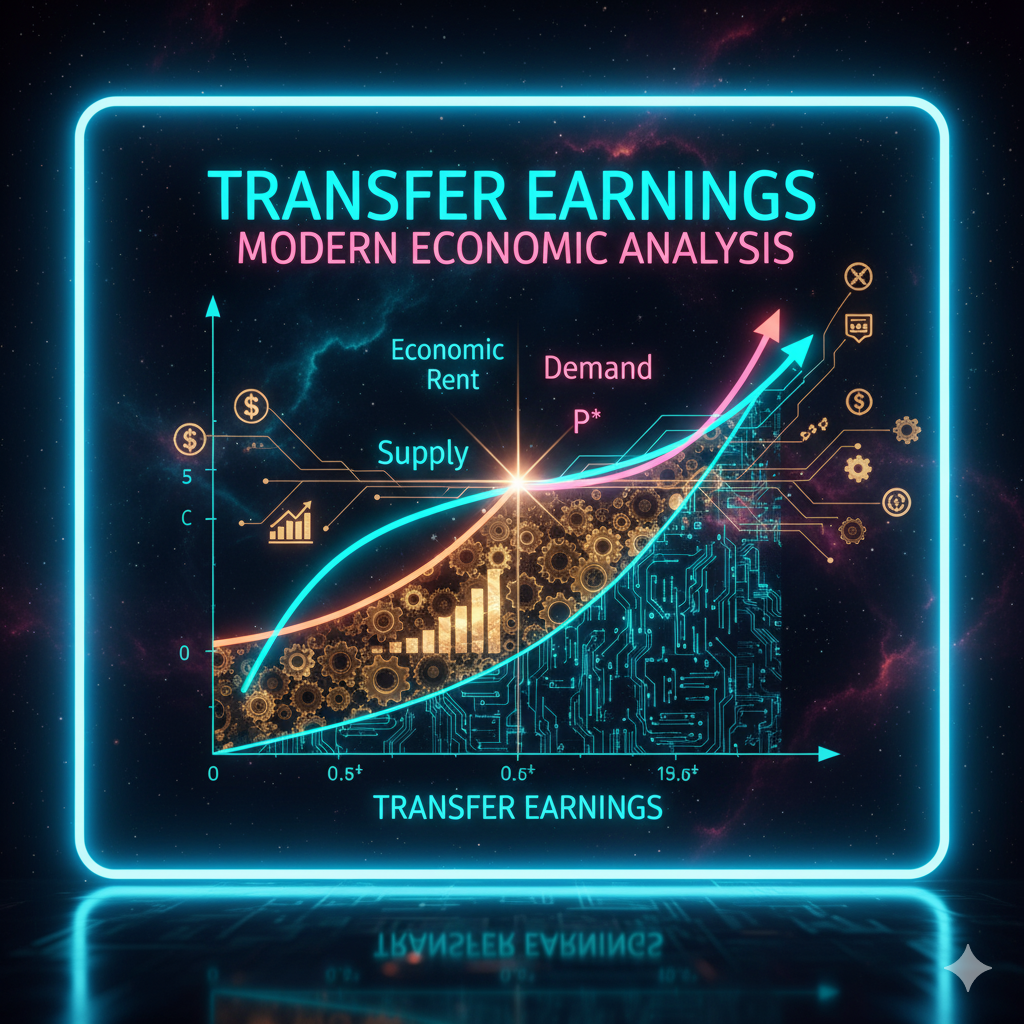Introduction
In microeconomics, the theory of factor pricing is central to understanding how wages, rent, interest, and profits are determined in a competitive market. Modern economic analysis refines classical theories by incorporating the concept of transfer earnings, which plays a crucial role in the pricing of factors of production.
Transfer earnings refer to the minimum payment required to keep a factor of production in its current use, representing an opportunity cost perspective. Understanding this concept helps in explaining why wages, rents, and other factor incomes are set at certain levels, and it aids in analyzing the allocation of resources across different sectors of the economy.
This article provides a detailed explanation of transfer earnings, their role in factor-price determination, and uses diagrams to illustrate the concept clearly for educational purposes.
Concept of Transfer Earnings
1. Definition
Transfer earnings are the minimum earnings that a factor must receive to remain in its present occupation or employment. In other words, it is the income the factor could earn in its next best alternative use.
- The concept is closely related to opportunity cost in economics.
- Transfer earnings determine the baseline payment necessary to retain resources in a particular sector or occupation.
2. Example
- A skilled software engineer working in a company earns ₹80,000 per month.
- If she can earn ₹70,000 in an equally productive alternative job, her transfer earning is ₹70,000.
- The economic rent is the difference between actual earnings and transfer earnings:
Economic Rent=Actual Earnings−Transfer Earnings=80,000−70,000=10,000\text{Economic Rent} = \text{Actual Earnings} – \text{Transfer Earnings} = 80,000 – 70,000 = 10,000Economic Rent=Actual Earnings−Transfer Earnings=80,000−70,000=10,000
3. Components of Factor Payment
The total payment to a factor of production consists of two components:
- Transfer Earnings:
- Minimum amount to keep the factor in its current use.
- Determined by alternative employment opportunities.
- Economic Rent:
- Any surplus over transfer earnings.
- Arises due to scarcity, productivity, or unique skills.
Factor Price=Transfer Earnings+Economic Rent\text{Factor Price} = \text{Transfer Earnings} + \text{Economic Rent}Factor Price=Transfer Earnings+Economic Rent
Diagram 1: Transfer Earnings and Economic Rent
- Horizontal axis: Quantity of Factor
- Vertical axis: Factor Payment
- Base portion: Transfer earnings
- Upper portion: Economic rent
Role of Transfer Earnings in Factor-Price Determination
Modern economic analysis, especially under marginal productivity theory, explains factor pricing using transfer earnings and economic rent.
1. Factor Demand and Marginal Productivity
- A firm demands a factor up to the point where marginal revenue product (MRP) equals the factor price (wage, rent, etc.).
\text{MRP} = \text{Price of Factor (P_f)}
- MRP is the additional revenue generated by employing one more unit of a factor.
- Transfer earnings represent the minimum factor payment necessary to retain the resource, while economic rent arises if MRP exceeds transfer earnings.
2. Role in Wages
- Consider labor as the factor:
- Transfer earnings = minimum wage to retain labor in current occupation.
- Economic rent = additional wage paid due to skill, scarcity, or bargaining power.
- Total wage = Transfer earnings + Economic rent.
Diagram 2: Labor Market Factor Price Determination
- Downward-sloping labor demand curve (MRP curve).
- Upward-sloping labor supply curve.
- Equilibrium wage: Intersection of supply and demand.
- Portion below equilibrium wage = transfer earnings, portion above = economic rent.
3. Role in Rent
- Land or natural resources have perfectly inelastic supply.
- Entire payment may constitute economic rent; transfer earnings may be negligible if land has no alternative use.
- Example: Fertile land used for agriculture.
Diagram 3: Rent Determination
- Vertical supply curve for land (perfectly inelastic).
- Intersection with MRP determines rent.
- Entire payment = Economic rent; transfer earnings = 0 if land has no alternative use.
4. Role in Capital and Interest
- Capital has alternative uses, so transfer earnings represent minimum return required to keep capital in a particular investment.
- Interest = Transfer earnings (minimum return) + any economic rent (excess return due to scarcity or monopoly).
Transfer Earnings in Modern Economic Analysis
Modern economists such as Marshall and Pigou emphasized that:
- Transfer earnings are crucial to understanding scarcity rents.
- Factor pricing is determined by both supply and marginal productivity, not merely historical cost.
- Economic rent arises only when a factor is fixed in supply or exceptionally productive.
1. Opportunity Cost Perspective
- Transfer earnings = opportunity cost of employing the factor in current use.
- Example:
- A teacher earning ₹50,000/month in a private school
- Could earn ₹40,000/month elsewhere
- Transfer earnings = ₹40,000
- Economic rent = ₹10,000
2. Modern Factor-Pricing Principle
- Modern theory divides factor price into transfer earnings and economic rent.
- Factor is paid at least its transfer earnings; anything above represents surplus productivity or scarcity.
- This principle justifies differences in wages, rents, and profits across industries and regions.
Diagrammatic Illustration
1. Labor Market
- X-axis: Number of workers
- Y-axis: Wage rate
- Supply curve: Upward-sloping
- Demand curve (MRP): Downward-sloping
- Equilibrium wage: W*
- Transfer earnings: Area under supply curve up to equilibrium quantity
- Economic rent: Area above supply curve up to W*
2. Land Market
- X-axis: Quantity of land
- Y-axis: Rent per unit of land
- Supply curve: Vertical (fixed supply)
- Demand curve: Downward-sloping (MRP)
- Entire area = Economic rent; transfer earnings negligible
3. Capital Market
- X-axis: Units of capital
- Y-axis: Rate of return
- Supply curve: Slightly upward-sloping (alternative uses of capital)
- Equilibrium rate of return: Intersection with MRP
- Portion below equilibrium = transfer earnings
- Portion above = economic rent
Applications of Transfer Earnings
1. Wage Differentiation
- Explains why highly skilled labor earns more: transfer earnings are higher for skilled workers due to fewer alternatives.
2. Land Rent
- Scarce fertile land generates high economic rent; transfer earnings minimal.
3. Capital Investment Decisions
- Firms allocate capital to projects where MRP ≥ transfer earnings, ensuring optimal resource allocation.
4. Policy Implications
- Understanding transfer earnings helps in minimum wage policy, resource taxation, and rent control.
- Governments can distinguish between economic rent (taxable) and transfer earnings (minimum survival).
Critical Evaluation
- Strengths:
- Provides a clear basis for factor pricing.
- Separates opportunity cost from excess returns.
- Explains wage, rent, and interest differentials logically.
- Limitations:
- Difficult to measure transfer earnings accurately in dynamic markets.
- Assumes perfect knowledge of alternative uses and factor productivity.
- Modern labor markets may not follow MRP principles due to unionization or institutional factors.
Summary
- Transfer Earnings: Minimum payment needed to retain a factor in its current use; represents opportunity cost.
- Economic Rent: Payment over transfer earnings due to scarcity, productivity, or unique attributes.
- Factor-Price Determination: Factor price = Transfer earnings + Economic rent.
- Role in Modern Analysis: Explains wages, rents, interest, and profits; helps in allocation of resources.
- Diagrammatic Understanding:
- Labor: Portion of wage = transfer earnings, rest = economic rent
- Land: Entire rent = economic rent if fixed supply
- Capital: Transfer earnings = minimum return, rest = economic rent
Modern economic theory uses transfer earnings to explain factor allocation, pricing, and resource utilization efficiently, making it an essential tool for students, policymakers, and economists.
Conclusion
The concept of transfer earnings in modern economic analysis is critical for understanding how factor prices are determined. It separates the minimum payment needed to retain a factor from economic rent, providing clarity in wage, rent, and interest calculations. By combining marginal productivity principles with transfer earnings, economists can analyze resource allocation, factor mobility, and efficiency in both labor and capital markets.
- Labor markets: Transfer earnings ensure minimum wage; economic rent arises for scarce skills.
- Land markets: Scarce resources yield high economic rent.
- Capital markets: Return above transfer earnings attracts investment.
Diagrams illustrate that factor price determination is a combination of opportunity cost (transfer earnings) and marginal productivity (economic rent). This framework remains fundamental in modern economic analysis and policy formulation.




